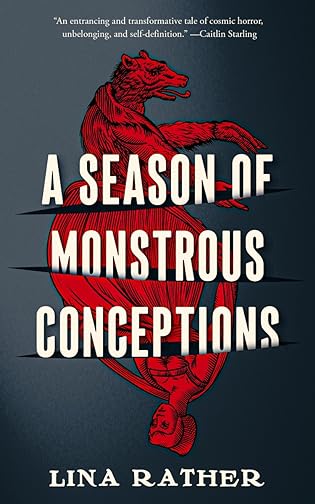 A Season of Monstrous Conceptions by Lina Rather
A Season of Monstrous Conceptions by Lina Rather Format: eARC
Source: supplied by publisher via Edelweiss
Formats available: hardcover, ebook, audiobook
Genres: Dark Fantasy, historical fantasy, horror
Pages: 161
Published by Tordotcom on October 31, 2023
Purchasing Info: Author's Website, Publisher's Website, Amazon, Barnes & Noble, Kobo, Bookshop.org, Better World Books
Goodreads
In 17th-century London, unnatural babies are being born: some with eyes made for the dark, others with webbed fingers and toes better suited to the sea.
Sarah Davis is intimately familiar with such strangeness—she herself was born marked by uncanniness. Having hidden her nature all her life and fled to London under suspicious circumstances, Sarah starts over as a midwife’s apprentice, hoping to carve out for herself an independent life. As a member of the illegal Worshipful Company of Midwives, Sarah learns to reach across the thinning boundary between her world and another, drawing on its power to heal and protect the women she serves.
When the wealthy Lady Wren hires her to see her through her pregnancy, Sarah quickly becomes a favorite of her husband, the famous architect Lord Christopher Wren, whose interest in the uncanny borders on obsession. Sarah soon finds herself caught in a web of magic and intrigue created by those who would use the magic of the Other World to gain power for themselves, and whose pursuits threaten to unmake the earth itself.
My Review:
Sarah Davis, widow and apprentice midwife, knows all too well that some babies are born who are not meant to live in this world, because she was nearly one of them. But in London in the winter of 1675, when this story takes place, there has been a sudden epidemic of babies being born who are not meant to live in THIS particular world, but rather, a different one where their horns or tails or fur or fangs or even gills would not be the least bit strange or embarrassing for their families. Or otherwise instantly fatal.
It’s not really surprising that this sudden and vast increase in strange and frequently stillborn babies results in accusations of witchcraft and consorting with the devil. (The Salem Witch Trials are still 18 years in the future at this point.)
Actually, from the descriptions of some of the babies, I’m not sure we’d avoid bandying about accusations of witchcraft if it happened TODAY. Demonizing women for their pregnancies or the causes or the results thereof is just as pervasive today as it was in the late 17th century – or any other.
But Sarah is a midwife. She is also, herself, one of those strange children, but when she was born such children were not nearly so common, and her strangeness was one that could be easily snipped away. Literally. She was born with a tail, and an ability to touch on something that her fellow midwives refer to as the ‘Other Place’.
In other words, Sarah has magic. Many of the midwives have a bit, but Sarah has a lot – she just can’t consciously tap into it.
Sir Christopher Wren, very much on the other hand, has money and influence. He has an education and is a well-known scientist as well as an architect. And his wife Faith is very near to term with their second child. A child who was conceived for the sole purpose of opening a gate between this world and that ‘Other Place’ in order to fix the overlap or incursion between the worlds that is causing conditions in both this place and the ‘Other’ to go so very much askew.
Wren believes he’s using Sarah for her power. And he is because he can and he believes he’s right to do so because he knows best. He isn’t and he doesn’t.
Sarah, on the other hand, knows enough. Maybe. Hopefully. Just possibly. Enough.
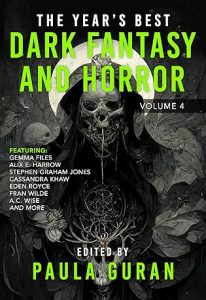 Escape Rating A-: You remember that Year’s Best collection of Dark Fantasy and Horror that I reviewed last week? A Season of Monstrous Conceptions would have fit in perfectly because it sits right at the haunted crossroads between the two. I went into this book expecting it to be firmly on the Horror side of the fence, and that’s the way it started out, but it crawled over into that crossroads and just a little over to the Dark Fantasy side and planted itself there with its too many eyes and too sharp teeth and crashing worlds and glared at me until I felt sorry for it and realized that I liked it a whole lot more than I ever expected.
Escape Rating A-: You remember that Year’s Best collection of Dark Fantasy and Horror that I reviewed last week? A Season of Monstrous Conceptions would have fit in perfectly because it sits right at the haunted crossroads between the two. I went into this book expecting it to be firmly on the Horror side of the fence, and that’s the way it started out, but it crawled over into that crossroads and just a little over to the Dark Fantasy side and planted itself there with its too many eyes and too sharp teeth and crashing worlds and glared at me until I felt sorry for it and realized that I liked it a whole lot more than I ever expected.
This ‘season’ takes place as alchemy was giving way to chemistry. Folk medicine and midwifery, both the practice of women, was being supplanted by trained doctors and surgeons, exclusively male provinces. Magic was fading and logic was taking its place.
This story sits at that juncture. On the one hand, the events taking place are utterly eldritch but clearly quite real. The evidence of babies born with compound eyes, gills and multiple limbs, sometimes all in the same poor creature, is hard to dispute, but it’s not the only thing going wrong in this winter of 1675.
What makes the story interesting revolves around the disparate potential solutions. The magical midwives know it’s happening, believe their magic can fix it, but don’t know quite enough of the science of how the multiverse works to get their fix quite right.
Wren has all the scientific knowledge necessary, as well as the flexibility of mind to accept otherwise unpalatable solutions, but the magic the midwives use is a trade secret he has no access to. His science is just enough to tell him that it’s not enough, either.
Sarah is our point of view character because she stands as the knife edge of balance between all the various factions and forces. She wants to believe that Wren sees her as an intelligent and capable person in her own right, instead of just someone he can use. She already knows that the midwives are using her. She’s caught between the magic she has and the training she gets that does not know how to help her access it. She sees that things are going horribly awry but can’t fix them on her own.
In the end, it’s Sarah’s choices that define both her course and her solution. Watching her use her power but not letting it or anyone around her use her, and her own personal why of it all, makes her a terrific perspective on this story and makes this story a surprising and creepy and often surprisingly creepy delight from beginning to end – just perfect for this Halloween week.

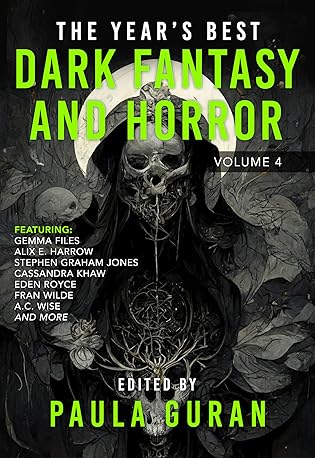 The Year's Best Dark Fantasy & Horror: Volume Four by
The Year's Best Dark Fantasy & Horror: Volume Four by 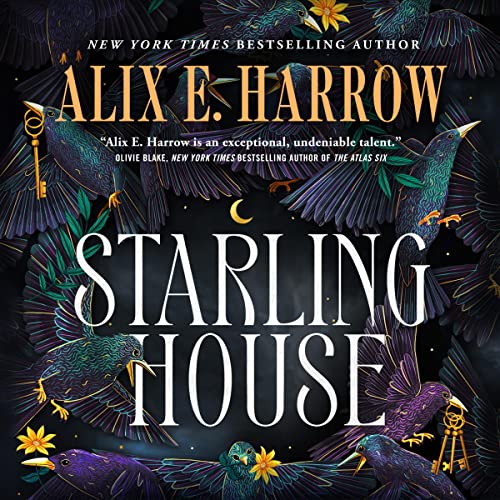 Starling House by
Starling House by 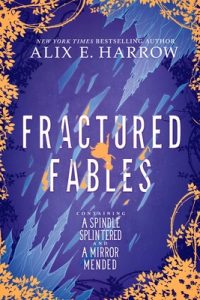 I took this journey in audio, with Natalie Naudus as the most excellent narrator. As a narrator, she seems to specialize in heroines who think that everything is all their fault and that they have to do it all alone, and her voice made me think of her other characters, Emiko Soong in
I took this journey in audio, with Natalie Naudus as the most excellent narrator. As a narrator, she seems to specialize in heroines who think that everything is all their fault and that they have to do it all alone, and her voice made me think of her other characters, Emiko Soong in 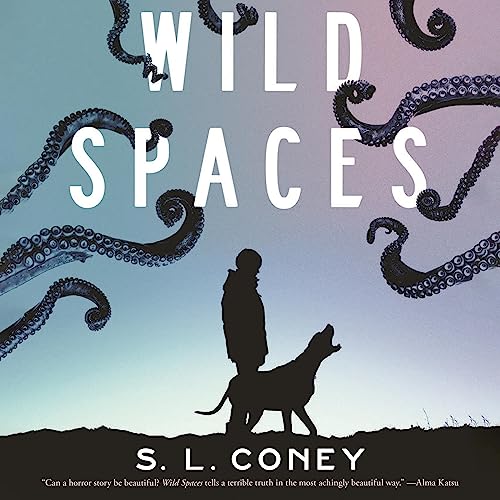 Wild Spaces by
Wild Spaces by 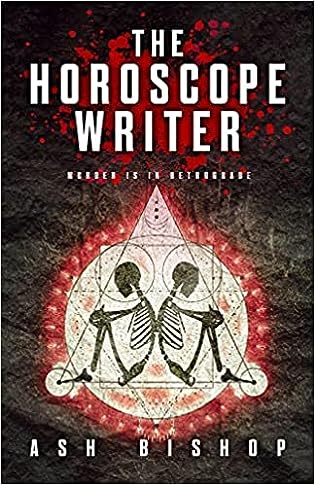 The Horoscope Writer by
The Horoscope Writer by 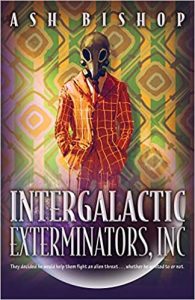 Escape Rating B-: I picked up The Horoscope Writer because I reviewed the author’s debut novel,
Escape Rating B-: I picked up The Horoscope Writer because I reviewed the author’s debut novel, 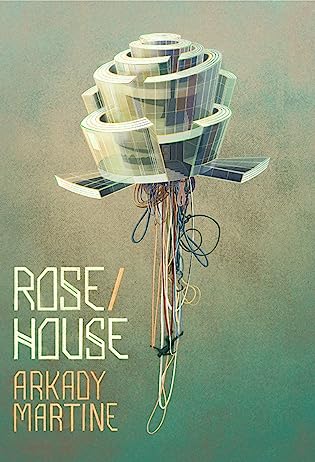 Rose/House by
Rose/House by 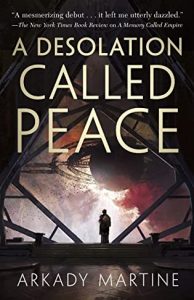 Escape Rating B-: I picked this up because I still miss Teixcalaan. (Yes, I know I said that the ending of
Escape Rating B-: I picked this up because I still miss Teixcalaan. (Yes, I know I said that the ending of 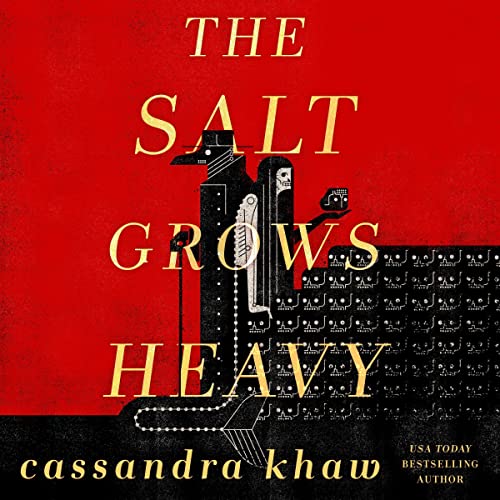 The Salt Grows Heavy by
The Salt Grows Heavy by 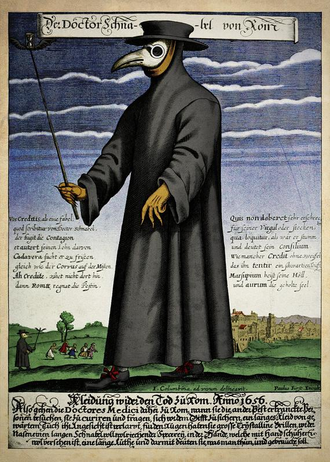
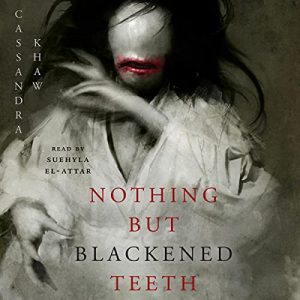 It wasn’t quite as cohesive a story as
It wasn’t quite as cohesive a story as 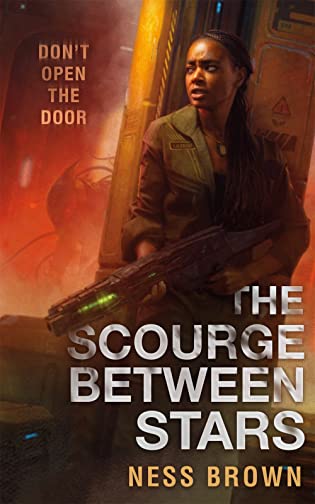 The Scourge Between Stars by
The Scourge Between Stars by 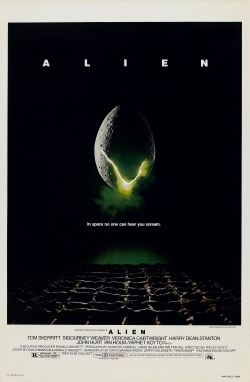 Escape Rating A-: Whether The Scourge Between Stars is science fiction or horror depends on which side of that divide the reader thinks the movie
Escape Rating A-: Whether The Scourge Between Stars is science fiction or horror depends on which side of that divide the reader thinks the movie 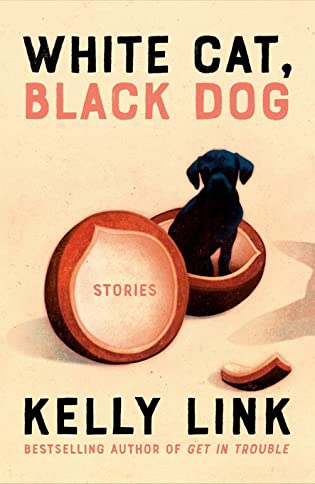 White Cat, Black Dog: Stories by
White Cat, Black Dog: Stories by 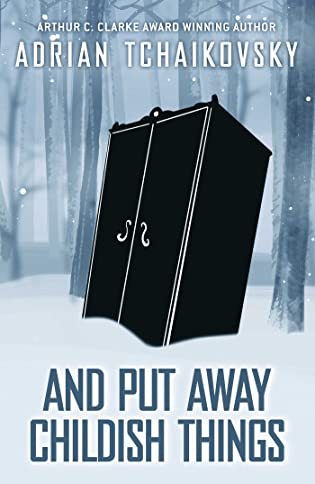 And Put Away Childish Things by
And Put Away Childish Things by 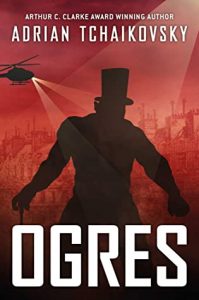 Instead, And Put Away Childish Things mixes the central theme of
Instead, And Put Away Childish Things mixes the central theme of